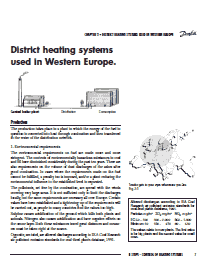Environmental requirements
The environmental requirements on fuel are made more and more stringent. The contents of environmentally hazardous substances in coal and oil have diminished considerably during the past ten years.
There are also requirements on the volume of dust discharges of the ashes after good combustion. In cases where the requirements made on the fuel cannot be fulfilled, a penalty tax is imposed, and/or a plant reducing the environmental influence to the established level is requested.
The pollutants, set free by the combustion, are spread with the winds covering very large areas. It is not sufficient only to limit the discharges locally, but the same requirements are necessary all over Europe. Certain values have been established and a tightening-up of the requirements will be carried out, as people in many countries find the values too high.
Sulphur causes acidification of the ground which kills both plants and animals. Nitrogen also causes acidification and have negative effects on the ozone layer. Both these substances travel great distances and measures must be taken right at the source. Opposite, are allowed discharges according to IEA Coal Research air pollutant emission standards for coal-fired plants database, 1991.
Hydrocarbons derived from motor-driven vehicles and industrial processes contribut to the fact that ozone is formed close to the ground and the fact that the ozone layer is demolished. Greenhouse gases, carbon dioxide, nitrous oxide and methane are all contributing to the so-called greenhouse effect. Carbon dioxide is formed by different sorts of combustion, in central heating plants, in car engines etc. Heavy alloys, which influence the germ plasm, are stored all the time, and gradually they end up at the top of the food chain, i.e. in predators and in human beings.
Fuel
Oil and coal are the fuels most frequently used. Natural gas is more and more used as well as biofuel (renewable energy such as forest waste and straw).
Coal is refined through washing so that the content of pollutants and ashes will be less than before. The sulphur content is under 0.8 %. By spraying with surface chemicals or with water only, the dust amount from transport and handling has been reduced. Pulverized coal is a processing operation that increases the efficiency of handling and combustion. Efficient purification of the exhaust gases is required, bearing in mind solid particles, sulphur and nitrogen gas.
Because of the large volumes in connection with district heating, the transport must be carried out by ship, unless of coal mine is located near the district heating plant.
Oil for large district heating systems, so called heavy oil, contains a maximum of 0.8% sulphur and can be very efficiently burnt with present techniques, but to reduce the discharges to the accepted level, purification of the exhaust gases is required. The oil is tranported by ship and lorry or by train. Gas can be purified from possible pollutants before combustion, but nitrogen remains even after the combustion. When dealing with large quantities in liquid form, transport is undertaken by special tankers or through gas pipe-lines.
Biofuel is mostly used in minor plants, up to 10.000 apartments, 700.000 m2. Biofuel is not considered to have negative effects on the environment, as the carbon dioxide, released by the combustion, is used when the corresponding amount of biofuel is building up.
| Title: | 8 STEPS – CONTROL OF HEATING SYSTEMS Part 2 – Control of heating systems used in Western Europe |
| Format: | |
| Size: | 1.1MB |
| Pages: | 20 |
| Download: | Right here | Video Courses | Membership | Download Updates |


